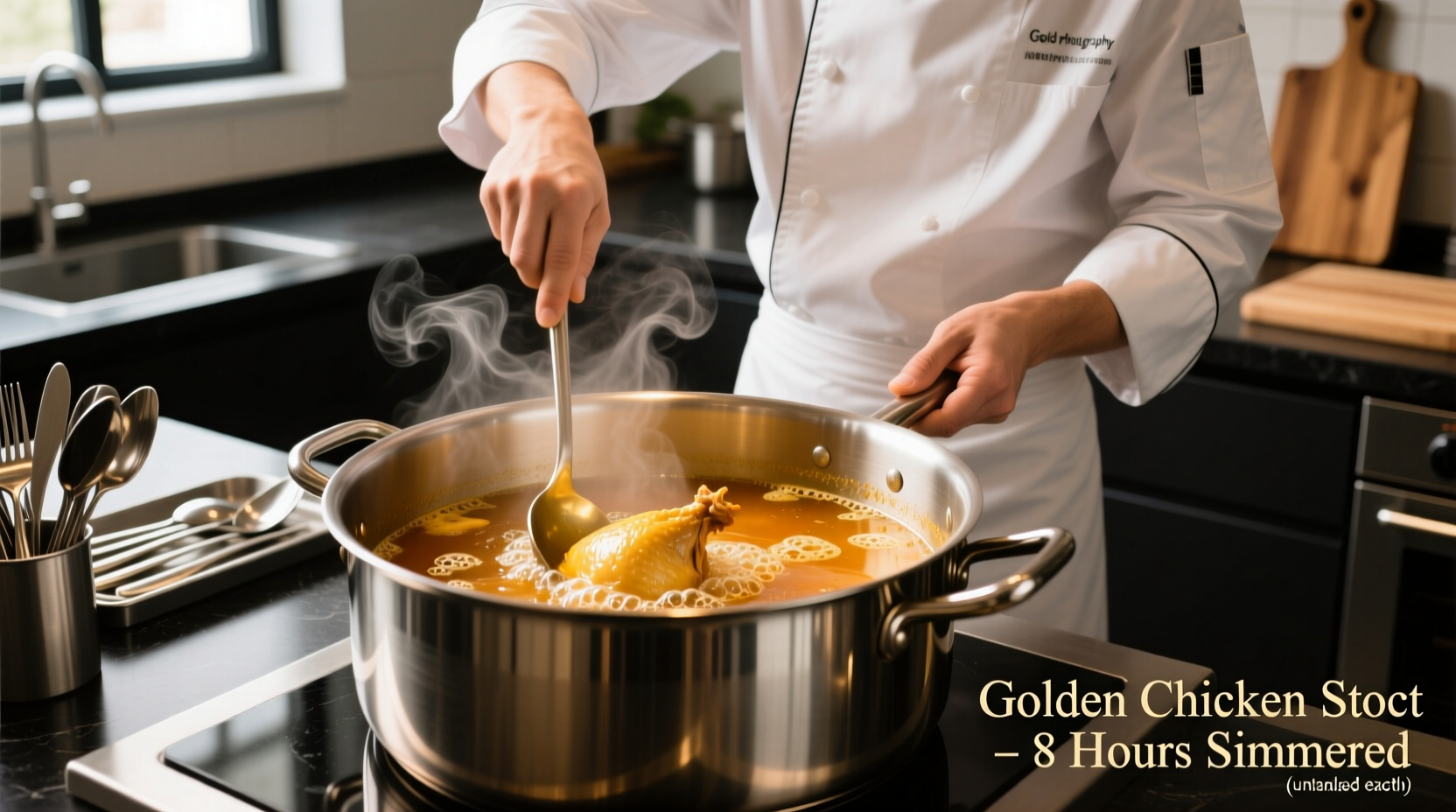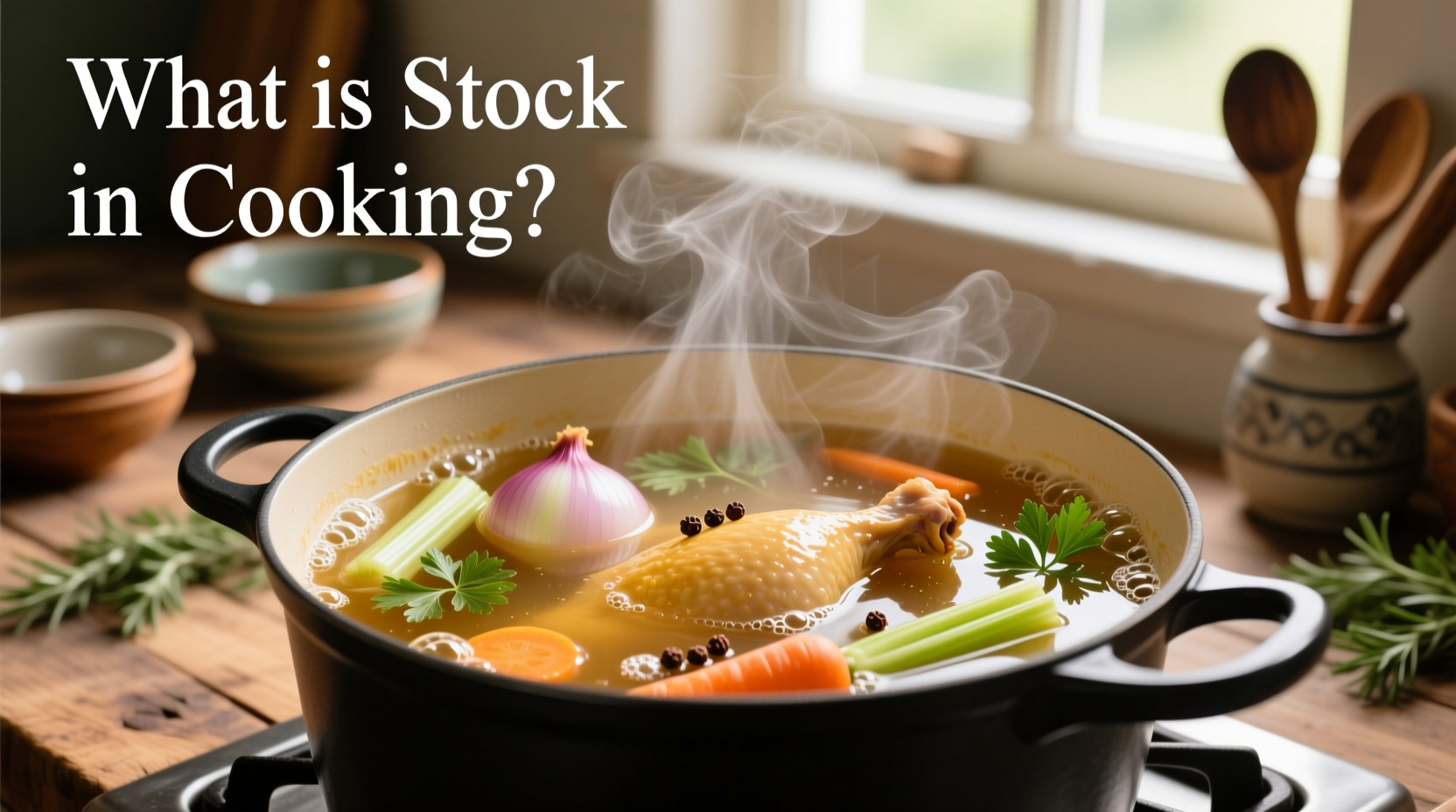Ever wonder why restaurant dishes have that deep, complex flavor you can't quite replicate at home? The secret often lies in properly made stock—a culinary cornerstone that transforms ordinary meals into extraordinary creations. As a French-trained chef with decades of experience, I've seen how understanding this fundamental element elevates home cooking from good to exceptional.
The Essential Foundation: What Stock Really Is
Stock isn't just liquid—it's concentrated cooking wisdom in a pot. At its core, stock is a flavorful cooking liquid created through the slow extraction of collagen, gelatin, and soluble proteins from bones, combined with the aromatic essence of vegetables and herbs. This process, perfected over centuries, creates a versatile base that forms the backbone of countless culinary traditions worldwide.
Unlike broth (which focuses on meat flavor), stock's magic comes from bones. When simmered slowly, bones release collagen that converts to gelatin, giving stock its characteristic body and mouthfeel. This gelatin isn't just about texture—it's what allows sauces to coat properly and gives soups that luxurious, velvety quality you can't achieve with water alone.
| Characteristic | Stock | Broth | Consommé |
|---|---|---|---|
| Primary Base | Bones with少量 meat | Meat | Stock clarified with egg whites |
| Gelatin Content | High (forms jelly when chilled) | Low to moderate | Moderate (after clarification) |
| Cooking Time | 4-24 hours | 1-2 hours | Stock + 1-2 hours clarification |
| Primary Use | Sauces, braises, soup base | Finished soups, sipping | Clear soups, refined presentations |
Why Stock Matters: The Science Behind the Flavor
Understanding stock's role goes beyond tradition—it's culinary chemistry in action. When bones simmer for hours, they release not just flavor compounds but also glutamates and inosinates that create umami, the fifth taste sensation responsible for that deep, satisfying savoriness. This scientific principle explains why dishes made with proper stock taste more complex and satisfying than those using water or store-bought alternatives.
The USDA's Food Safety and Inspection Service confirms that proper stock preparation requires maintaining temperatures between 165°F-185°F (74°C-85°C) for optimal extraction without boiling, which would make the stock cloudy and bitter. This precise temperature control separates professional results from amateur attempts.
From Medieval Kitchens to Modern Stovetops: The Evolution of Stock
Stock-making has evolved significantly through culinary history. In medieval times, cooks maintained perpetual pot-au-feu (fire pot), constantly adding ingredients to a single pot that simmered for weeks. The French culinary revolution of the 17th century introduced the concept of clear, refined stocks as foundational elements.
By the 19th century, Auguste Escoffier codified stock-making principles in his seminal work Le Guide Culinaire, establishing the "five mother sauces" all built upon proper stock. Today's techniques balance tradition with modern understanding of food science, optimizing extraction while respecting time constraints of contemporary kitchens.
Building Blocks of Exceptional Stock
Creating professional-quality stock requires understanding each component's role:
Bones: The Flavor Foundation
Choose bones with high collagen content—knuckle bones, marrow bones, and poultry backs work best. Roasting bones first (at 400°F/200°C for 30-45 minutes) creates Maillard reactions that deepen flavor complexity. According to the Culinary Institute of America's Professional Chef, roasted bones yield stock with 30% more flavor compounds than raw bones.
Aromatics: The Flavor Enhancers
The classic mirepoix (2 parts onion, 1 part carrot, 1 part celery) forms the aromatic base. Additions like leeks, parsley stems, and bay leaves contribute nuanced flavors. Remember: never use bitter vegetable parts (like celery leaves in large quantities) that can overpower your stock.
Liquid: The Extraction Medium
Always start with cold water to gradually extract flavors. The water-to-ingredients ratio matters—too little water creates overpowering stock, while too much dilutes flavor. A good rule: cover ingredients by 1-2 inches of water.

Your Step-by-Step Stock Journey
Follow this practical sequence to create professional-quality stock at home:
Preparation Phase: Setting Up for Success
Gather your ingredients—2-3 pounds of bones, 1 chopped onion, 1 chopped carrot, 1 chopped celery stalk, 1 bay leaf, and 10-12 black peppercorns. For chicken stock, add 1-2 tablespoons of tomato paste to enhance color and flavor development.
Cooking Phase: The Art of Simmering
Place ingredients in a large stockpot, cover with cold water, and bring to just below a boil. Immediately reduce heat to maintain a gentle simmer—bubbles should barely break the surface. Skim impurities during the first 20 minutes. Simmer chicken stock for 3-4 hours, beef stock for 6-8 hours, and fish stock for 30-45 minutes.
Finishing Phase: Perfecting Your Stock
Strain through a fine-mesh sieve lined with cheesecloth for crystal-clear results. Never press solids—this forces impurities into your stock. Cool rapidly by placing the pot in an ice bath, then refrigerate. The next day, remove the solidified fat layer from the surface for cleaner flavor.
Avoiding Common Stock-Making Mistakes
Even experienced cooks make these critical errors:
- Boiling instead of simmering: Creates cloudy, bitter stock. Maintain that gentle bubble
- Overloading vegetables: Too many aromatics creates vegetable-forward flavor rather than balanced stock
- Adding salt too early: Concentrates during reduction, making final product too salty
- Using old or frozen bones: Fresh bones yield significantly better flavor extraction
Storage and Usage: Maximizing Your Stock
Proper storage maintains quality and safety. The FDA Food Code recommends cooling stock from 140°F to 70°F within 2 hours, then to 41°F within an additional 4 hours. Store in airtight containers:
- Refrigerator: Up to 4 days
- Freezer: 6 months in containers, up to 1 year in vacuum-sealed bags
- Reduced glace de viande: Concentrated stock that keeps indefinitely frozen
When using stock, remember it's a flavor enhancer, not just liquid. Reduce it further for sauces to intensify flavor. Substitute water with stock in rice, grains, and braises for instant flavor upgrade. Freeze in ice cube trays for convenient portioning—perfect for deglazing pans or adding small amounts to dishes.
Frequently Asked Questions
Can I use stock instead of broth in recipes?
Yes, stock generally makes a superior substitute for broth due to its higher gelatin content and richer flavor profile. The main difference is that stock provides better body and mouthfeel in sauces and soups. When substituting, use a 1:1 ratio but reduce added salt since stock contains less sodium than most commercial broths.
Why does my homemade stock not gel when chilled?
Stock should gel when properly made due to gelatin extracted from bones. If it doesn't gel, common causes include insufficient bones with collagen (use more knuckle/marrow bones), cooking at too high temperature (boiling destroys gelatin structure), or not cooking long enough (chicken stock needs 3-4 hours minimum). Roasting bones first can increase gelatin yield by up to 25% according to culinary research.
How can I fix bitter stock?
Bitterness usually comes from overcooked vegetables (especially celery) or scorched ingredients. To fix slightly bitter stock, add a small amount of sugar (1/4 teaspoon at a time) or a peeled potato (which absorbs bitterness). For prevention, never let stock boil vigorously, remove vegetables after 1-2 hours of simmering, and avoid using vegetable peels that can impart bitter flavors.
Is it safe to leave stock simmering overnight?
According to USDA food safety guidelines, stock should not remain in the temperature danger zone (40°F-140°F) for more than 2 hours. If simmering overnight, maintain a gentle simmer (above 185°F) throughout, or use a slow cooker on low setting. Better practice: simmer during the day, then cool rapidly and refrigerate or freeze. Never leave stock sitting at room temperature overnight as this creates serious food safety risks.











 浙公网安备
33010002000092号
浙公网安备
33010002000092号 浙B2-20120091-4
浙B2-20120091-4